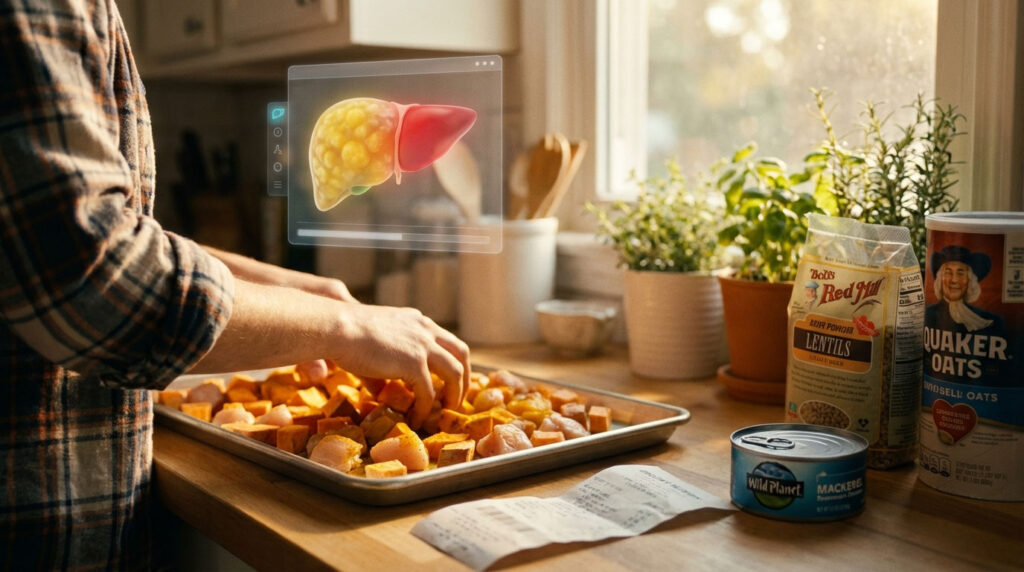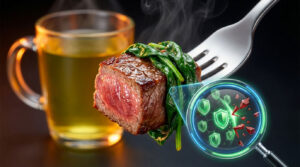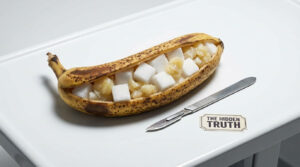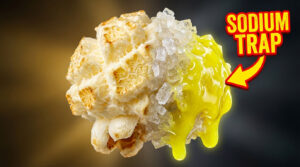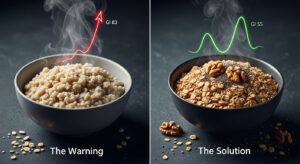Getting a diagnosis of high liver enzymes or hepatic steatosis often feels like a wake-up call you didn’t ask for. You leave the doctor’s office with a confusing sheet of paper, a new medical term like MASLD, and a vague instruction to “eat better and lose weight.” The anxiety sets in quickly. You worry that your future looks like a lifetime of boiled chicken, steamed broccoli, and expensive health food store receipts.
Table of Contents
That fear is unnecessary. The most effective way to heal your liver is not through deprivation or expensive “superfoods.” It is through a strategic, science-backed approach to nutrition that prioritizes your metabolic health. You do not need a personal chef or a bottomless budget. You simply need the right biology-based strategy.
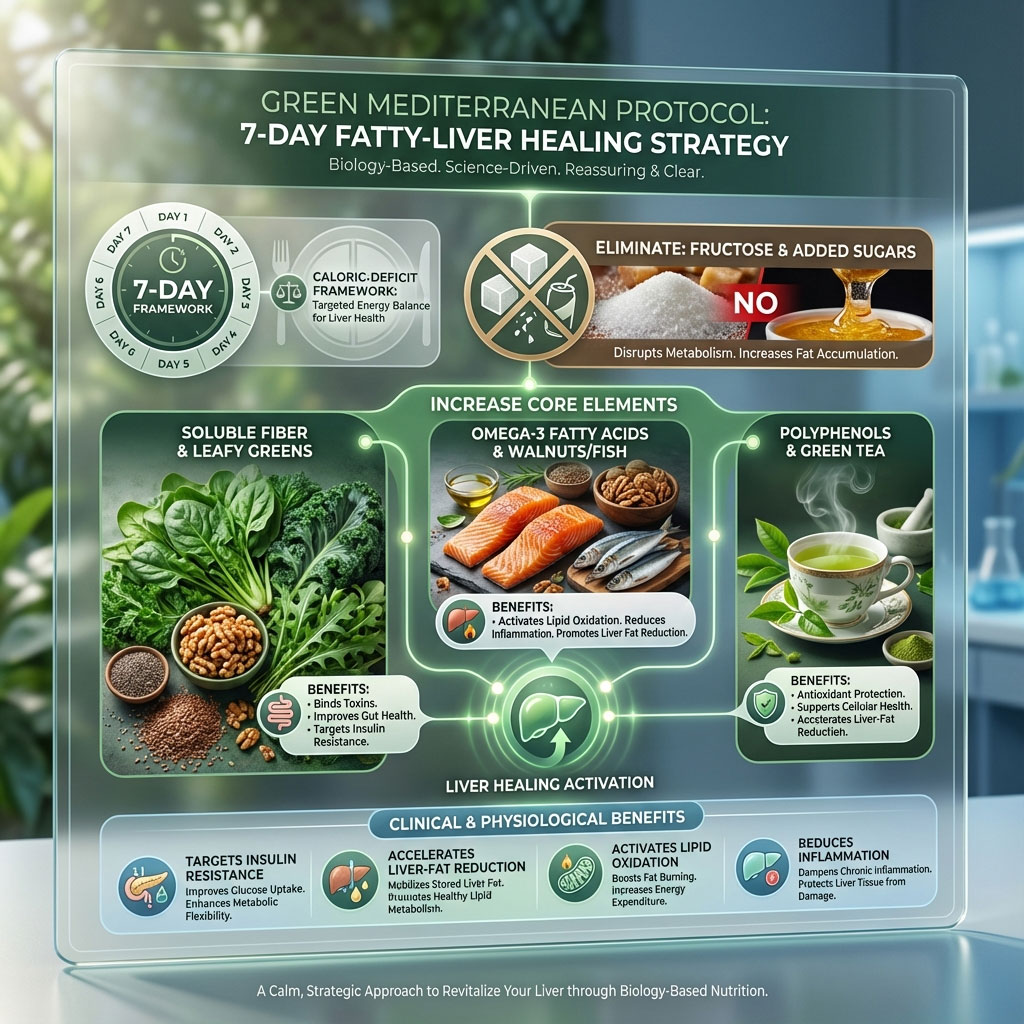
What is the best diet for fatty liver?
The most effective 7-day diet plan for fatty liver follows a Green Mediterranean protocol tailored for a caloric deficit. This approach targets insulin resistance by eliminating fructose and added sugars while aggressively increasing soluble fiber, omega-3 fatty acids, and polyphenols. Key dietary pillars include leafy greens, walnuts, fatty fish (like sardines or salmon), and green tea. This combination is clinically proven to reduce liver fat significantly faster than standard low-fat diets by activating lipid oxidation and reducing liver inflammation.
Understanding MASLD: Why Your Liver Needs a Reset
To fix a problem, you must first understand the mechanism behind it. The medical community has recently shifted terminology, moving away from Non-Alcoholic Fatty Liver Disease (NAFLD) to a more accurate term: Metabolic dysfunction-Associated Steatotic Liver Disease, or MASLD. This change is not arbitrary; it changes how we treat the condition.
From NAFLD to MASLD: What Changed?
This is not just a rebranding exercise. The shift to MASLD diet plan guidelines reflects a deeper understanding of the root cause. The old term, NAFLD, defined the disease by what you didn’t do, which was drink alcohol. The new term, MASLD, defines it by what is actually happening inside your body: metabolic dysfunction.
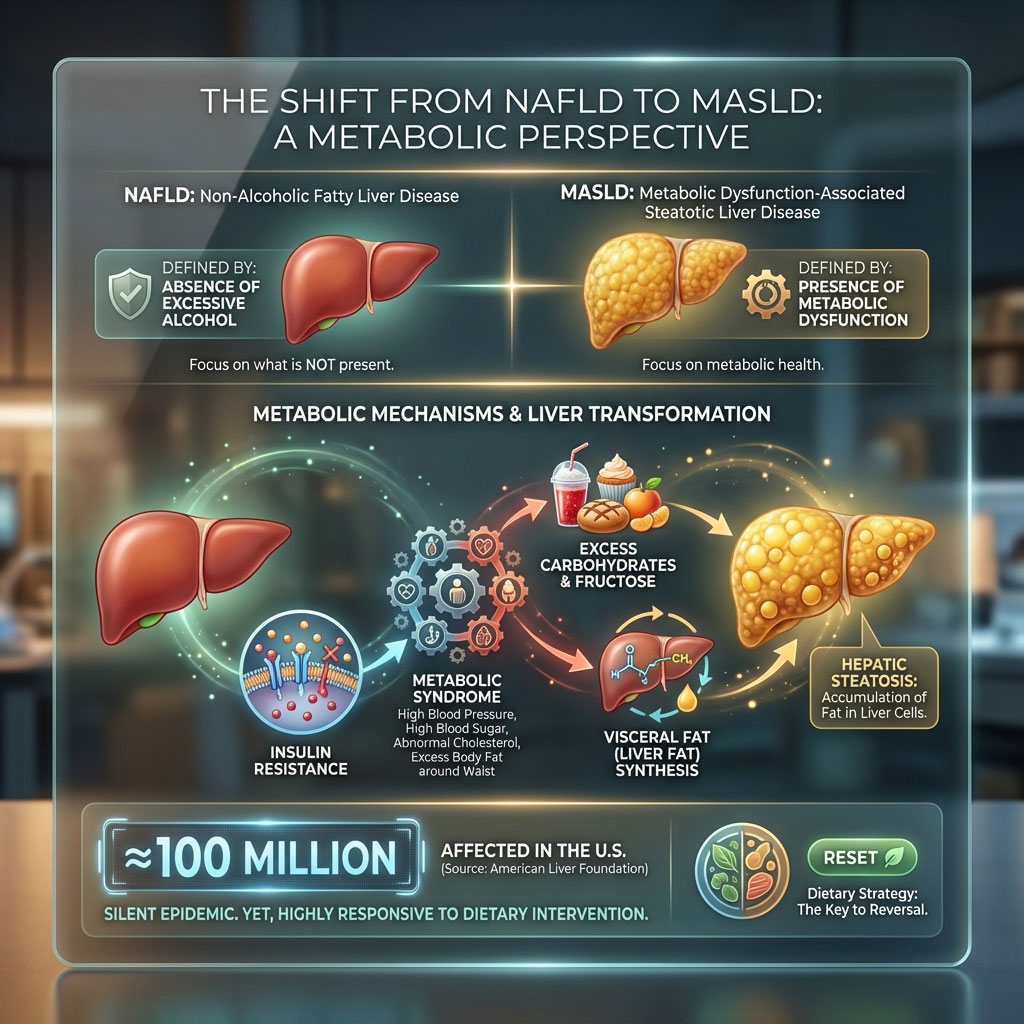
This condition is inextricably linked to insulin resistance and metabolic syndrome. When your body becomes resistant to insulin, your liver stops effectively processing glucose. Instead of using energy, your liver begins converting excess carbohydrates, specifically fructose, into visceral fat. This fat accumulates in the liver cells, leading to hepatic steatosis. According to the American Liver Foundation, this metabolic dysfunction affects roughly 100 million people in the U.S. alone, making it the most common chronic liver condition. It is a silent epidemic, but it is one that is highly responsive to dietary intervention.
The Mechanism of Hepatic Steatosis
Your liver is the chemical processing plant of your body. When you consume high amounts of refined carbohydrates and sugar, particularly high-fructose corn syrup found in sodas and processed snacks, your liver becomes overwhelmed. Unlike glucose, which every cell in your body can use for energy, fructose is metabolized almost entirely by the liver.
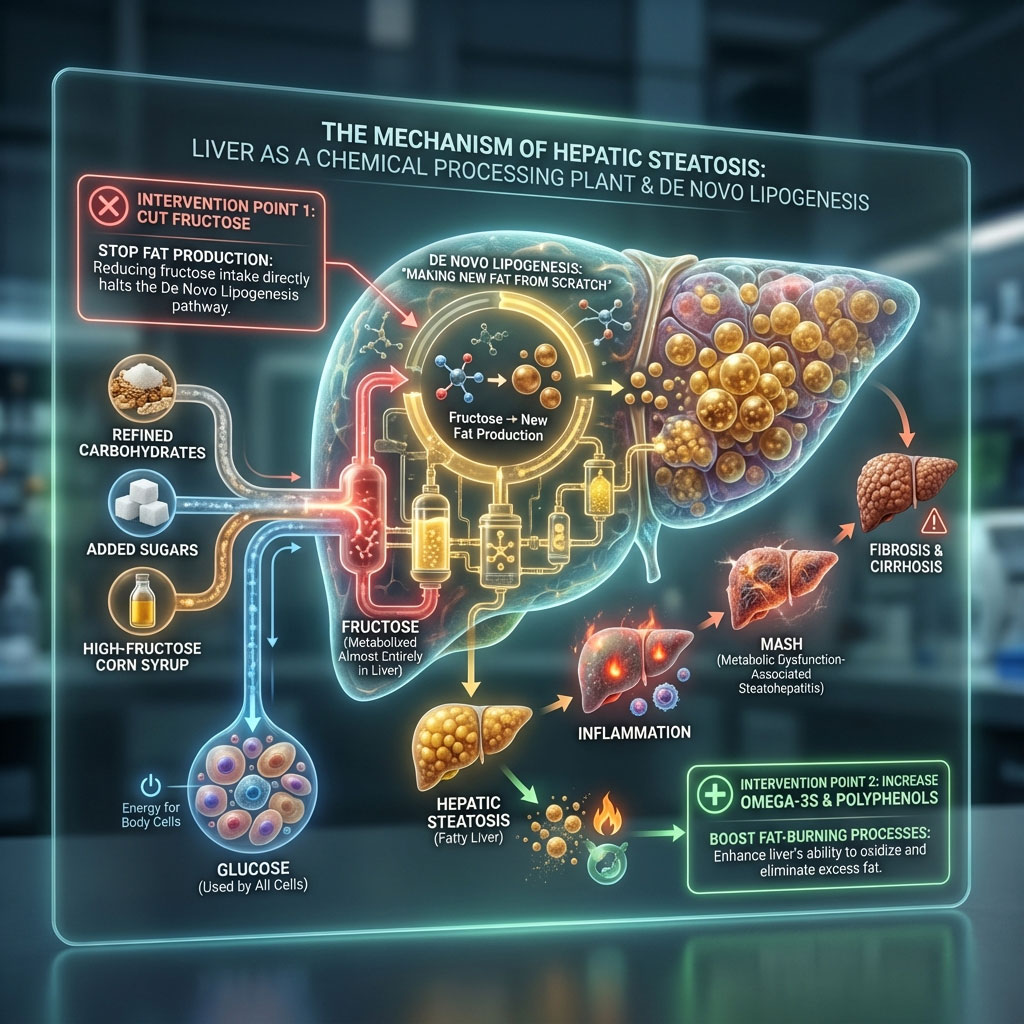
When the liver is flooded with fructose, it triggers a process called De Novo Lipogenesis. This literally means “making new fat from scratch.” This fat does not just sit under your skin; it infiltrates the liver tissue itself. Over time, this fat causes inflammation. This leads to a more severe condition known as MASH (Metabolic dysfunction-Associated Steatohepatitis), which can progress to fibrosis and cirrhosis. Understanding this pathway empowers you. To stop the fat production, you must cut the fuel source, which is fructose, and increase the fat-burning machinery, which includes Omega-3s and polyphenols.
Weight Loss Targets for Reversal
The good news is that the liver is the only organ in the human body capable of regenerating itself. According to major hepatology guidelines, a fatty liver diet plan does not require you to reach your ideal body weight overnight to see results. The biology of the liver is forgiving if you act decisively.

The clinical target is a body weight reduction of 5% to 10%.
5% Weight Loss
Losing just 5% of your total body weight significantly reduces liver fat content. This is often enough to normalize liver enzyme levels (ALT and AST) and reduce the “heaviness” or dull pain often felt in the upper right abdomen.
7-10% Weight Loss
Reaching a 10% reduction can reduce inflammation and potentially reverse early-stage fibrosis, or scarring. This is the gold standard for reversal.
A 7-day diet plan for fatty liver is your launchpad. While you cannot fully reverse years of damage in one week, seven days is enough to deplete liver glycogen stores, drop water weight, and begin the process of mobilizing liver fat. It provides the metabolic signal your body needs to switch from storage mode to burn mode.
The Strategy: The “Green Mediterranean” Advantage
If you search for a liver shrinking diet, you will find countless detox teas and juice cleanses. These are often dangerous scams that can actually stress the liver further. The gold standard for liver health is the Mediterranean diet for fatty liver, specifically a variation known as the “Green Mediterranean” diet.
Why the Mediterranean Diet is Gold Standard

Decades of research have established the Mediterranean diet as the premier approach for heart and metabolic health. It emphasizes whole grains, healthy fats like olive oil, lean proteins, and abundant vegetables. It works because it controls blood sugar without feeling restrictive. It is not a “diet” in the traditional sense, but a lifestyle pattern that prioritizes nutrient density.
However, for MASLD, we need to go a step further. We need to target the liver fat directly with specific bioactive compounds.
The “Green” Twist (Polyphenols & Omega-3s)
Recent clinical trials, such as the DIRECT-PLUS study, have shown that a “Green Mediterranean” diet reduces liver fat by nearly 39%. This is significantly higher than a standard Mediterranean diet. This is a game-changer for non-drug treatments.
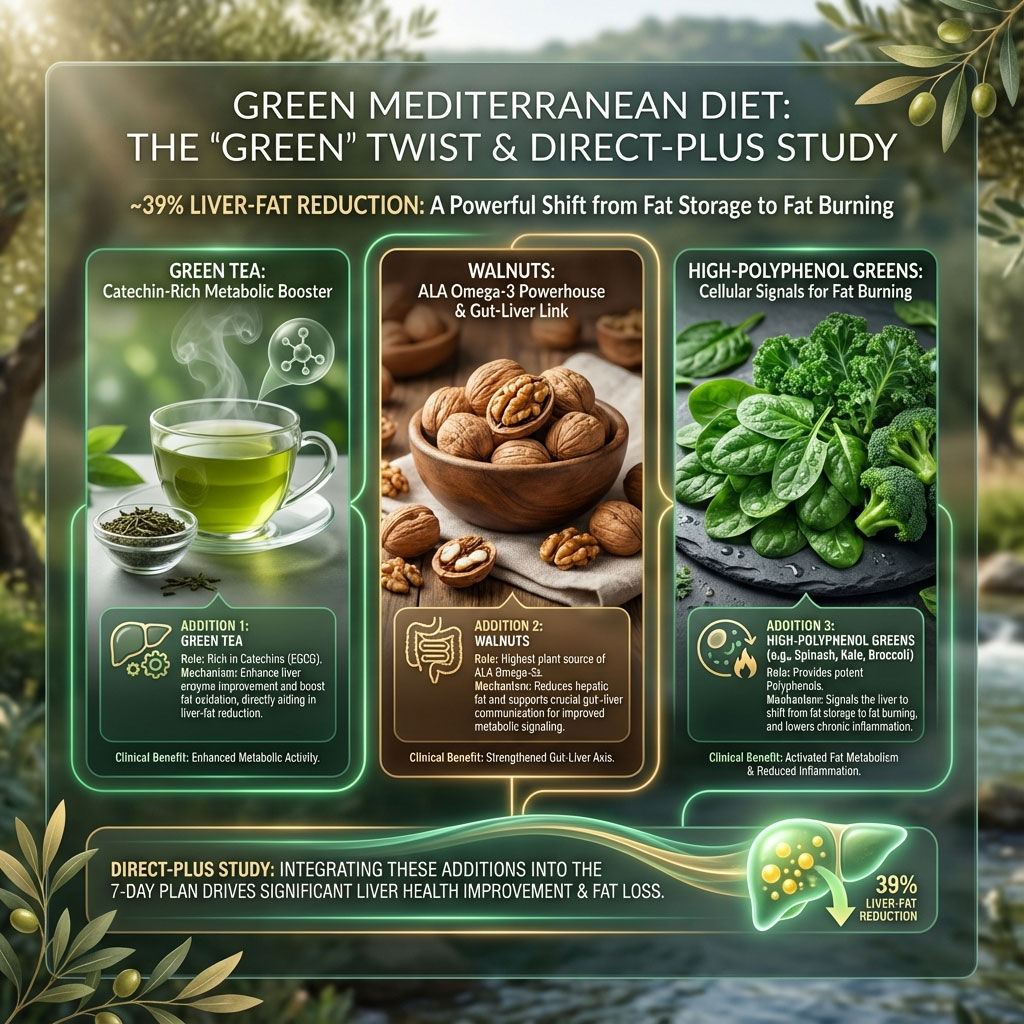
This variation includes three specific additions that you will find integrated into our 7-day plan:
1. Green Tea
Green tea is rich in catechins, specifically EGCG, which improve liver enzyme levels and fat oxidation. It acts as a metabolic accelerator.
2. Walnuts
Walnuts are the highest plant source of ALA Omega-3 fatty acids, which help reduce hepatic fat. They also improve the gut microbiome, which communicates directly with the liver.
3. High-Polyphenol Greens
The original study utilized an aquatic plant called duckweed. However, this is easily substituted with accessible options like spinach, kale, and broccoli, which are packed with similar compounds.
Polyphenols are compounds found in plants that act as antioxidants. In the context of a fatty liver meal plan 7 days, they act as cellular signalers that tell your liver to stop storing fat and start burning it. They essentially turn down the volume on liver inflammation.
Budget-Friendly Liver Health (USA Focus)
A major barrier to adopting a healthy fatty liver diet is the perception of cost. You might believe you need to shop at high-end organic markets to heal your liver. This is false. In fact, some of the most liver-friendly foods are the cheapest items in the grocery store. You can build a highly effective affordable fatty liver diet using staples found at Walmart, Aldi, or Costco.
The “Pantry Swap” Strategy
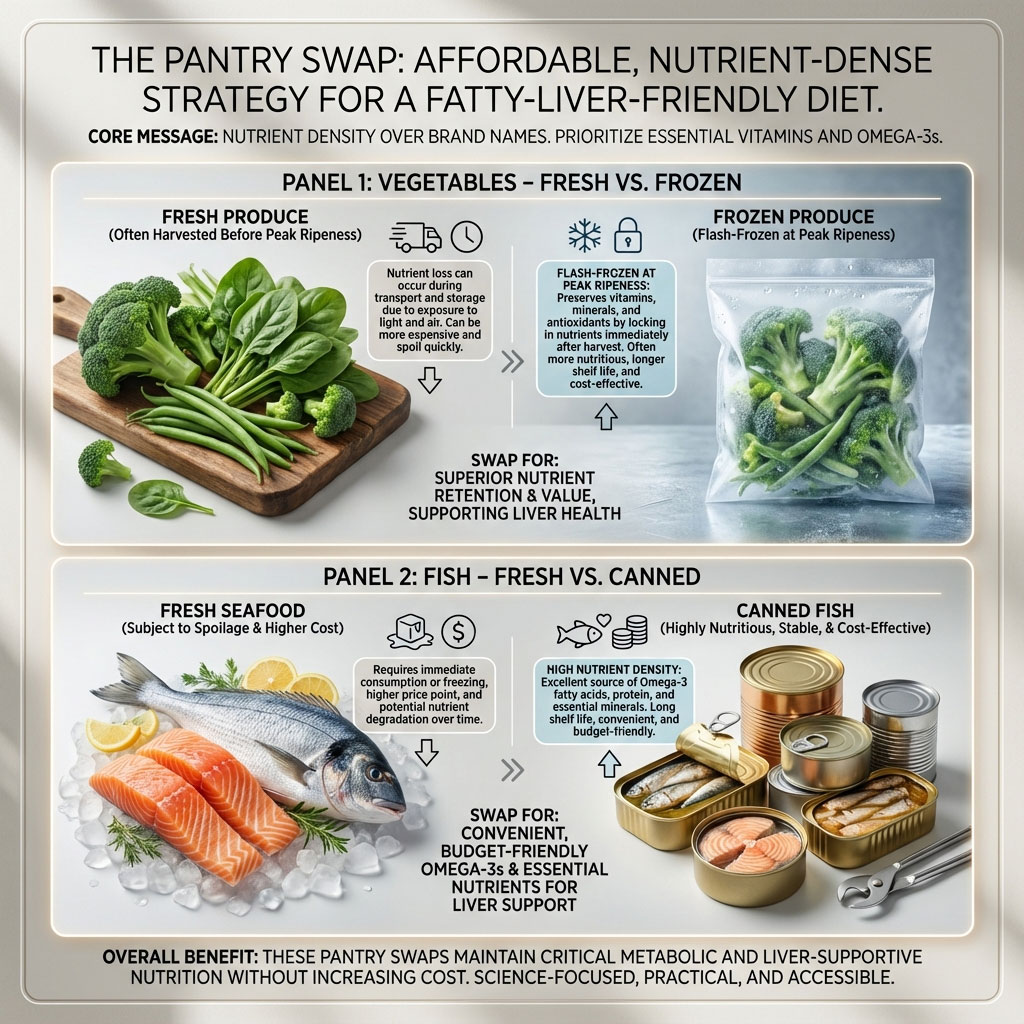
The key to affordability is prioritizing nutrient density over brand names. Frozen vegetables are often more nutritious than fresh ones because they are flash-frozen at peak ripeness, preserving their vitamin content. Canned fish is a powerhouse of nutrition for a fraction of the cost of fresh seafood.
Below is a breakdown of how to swap expensive items for budget-friendly alternatives that are equally effective for a MASLD diet plan.
| Expensive Influencer Choice | Affordable Liver Hero | Why It Works for MASLD | Estimated Savings |
| Fresh Wild Salmon ($16.99/lb) | Canned Mackerel or Sardines ($1.89/tin) | Higher concentration of Omega-3s and Calcium; lower mercury. | ~88% |
| Quinoa ($5.99/box) | Brown Rice or Dry Lentils ($1.49/lb) | Excellent source of soluble fiber to bind bile acids and lower cholesterol. | ~75% |
| Fresh Organic Berries ($6.99/pack) | Frozen Berry Medley ($2.99/bag) | Retains high polyphenol content; perfect for smoothies or oatmeal. | ~50% |
| Fancy Green Juice ($8.00/bottle) | Home-Brewed Green Tea ($0.10/cup) | Provides EGCG antioxidants without the sugar spike of fruit juices. | ~98% |
| Avocado Oil ($12.99/bottle) | Extra Virgin Olive Oil ($8.99/bottle) | High in oleic acid and polyphenols; the premier fat for liver health. | ~30% |
The 7-Day Diet Plan for Fatty Liver (Menu & Recipes)
This 7-day diet plan for fatty liver is designed to be simple, affordable, and delicious. The goal is to maximize fiber intake and healthy fats while keeping net carbohydrates controlled. This is not a low-calorie starvation plan. It is a high-nutrient restoration plan.
Daily Hydration Rule: Drink at least 64oz of water daily. Aim for 2-3 cups of unsweetened black coffee or green tea. Proper hydration is essential for the liver’s detoxification pathways.
Day 1: The Metabolic Reset
We start by cutting out all added sugars to help your insulin levels drop. This flush helps reduce water retention and bloating immediately.

Breakfast: “Golden Oats”
- Ingredients: ½ cup rolled oats (not instant), 1 cup water or unsweetened almond milk, ½ teaspoon turmeric, pinch of black pepper, 1 tablespoon chopped walnuts.
- Method: Cook oats on the stovetop for 5 minutes. Stir in turmeric and pepper at the end. Top with walnuts.
- Why It Works: Turmeric is a potent anti-inflammatory for the liver, but it requires black pepper for absorption. The soluble fiber in oats binds to cholesterol in the gut, preventing it from recirculating to the liver.
Lunch: Lentil Power Bowl
- Ingredients: 1 cup cooked lentils (canned is fine, rinse well), diced cucumber, parsley, red onion, lemon juice, 1 teaspoon extra virgin olive oil.
- Why It Works: Lentils are a low-glycemic superfood. High fiber intake helps stabilize blood sugar immediately, preventing the post-lunch energy crash often associated with insulin resistance.
Dinner: Sheet Pan Turmeric Chicken
- Ingredients: Boneless, skinless chicken thighs, 1 medium sweet potato (cubed), 1 cup frozen broccoli florets, garlic powder, paprika, olive oil.
- Method: Preheat oven to 400°F (200°C). Toss chicken and sweet potatoes in oil and spices. Spread on a baking sheet. Roast for 20 minutes. Add broccoli florets to the pan and roast for another 10–12 minutes until chicken reaches an internal temp of 165°F.
- Why It Works: Simple, one-pan meal high in protein and volume. Sweet potatoes provide beta-carotene without spiking blood sugar as drastically as white potatoes.
Snack
- Item: 1 apple with 1 teaspoon natural peanut butter. The pectin in the apple aids digestion.
Day 2: High Fiber Focus
Continuing the push for fiber to aid in toxin elimination and support the gut microbiome.
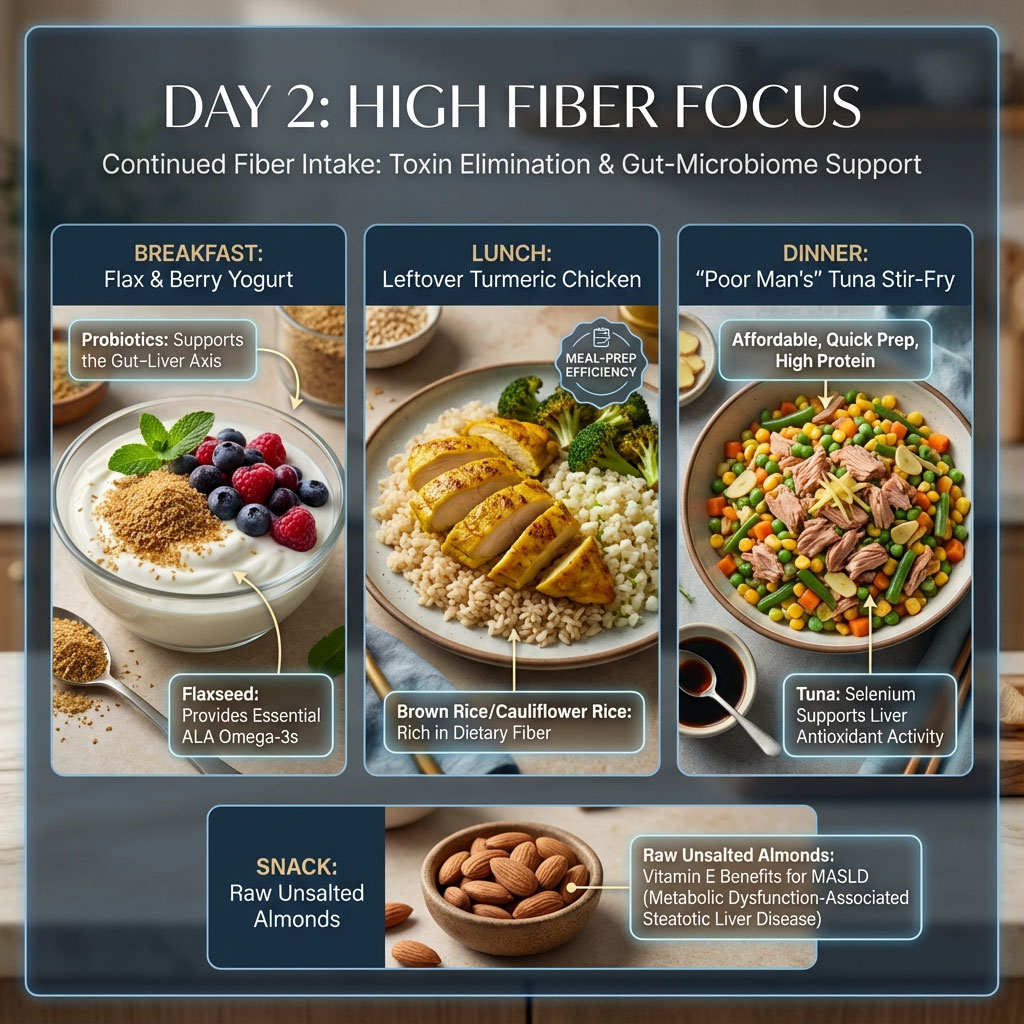
Breakfast: Flax & Berry Yogurt
- Ingredients: 1 cup plain non-fat Greek yogurt, 1 tablespoon ground flaxseed, ½ cup thawed frozen berries.
- Why It Works: Probiotics in yogurt support the gut-liver axis. A healthy gut prevents “leaky gut,” which stops bacterial toxins from reaching the liver. Flaxseed provides additional ALA Omega-3s.
Lunch: Leftover Turmeric Chicken
- Ingredients: Serve leftover chicken and veggies over ½ cup brown rice or cauliflower rice. Meal prepping saves time and ensures compliance.
Dinner: “Poor Man’s” Tuna Stir-Fry
- Ingredients: 1 can tuna (in water, drained), 1 bag frozen mixed vegetables (peas, carrots, corn, beans), ginger, garlic, low-sodium soy sauce.
- Method: Heat a skillet over medium-high heat with a spray of oil. Add frozen veggies and sauté for 5–7 minutes until tender-crisp. Add drained tuna, ginger, garlic, and 1 tbsp soy sauce. Stir-fry for another 2 minutes until heated through.
- Why It Works: An incredibly cheap, high-protein dinner ready in under 15 minutes. Tuna is lean and provides selenium, a mineral that acts as an antioxidant in the liver.
Snack
- Item: Handful of raw almonds (unsalted). Rich in Vitamin E, which is often prescribed for MASLD.
Day 3: Plant-Forward
Reducing meat intake occasionally lowers the metabolic load on the liver and increases phytonutrient intake.
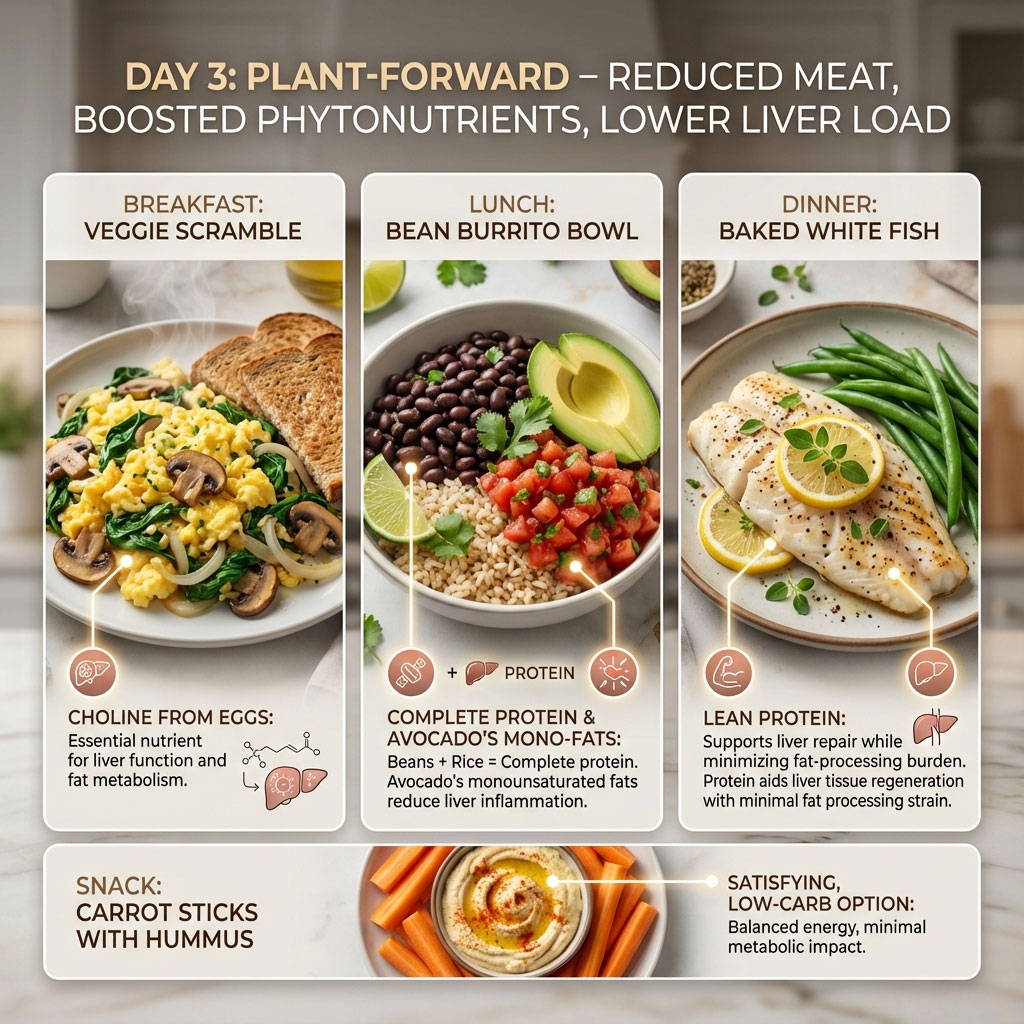
Breakfast: Veggie Scramble
- Ingredients: 2 eggs, handful of spinach, sliced mushrooms, diced onions, 1 slice whole-wheat toast.
- Why It Works: Eggs provide choline, essential for liver function. Choline deficiency is actually a known cause of fatty liver, so yolks are beneficial in moderation.
Lunch: Bean Burrito Bowl
- Ingredients: ½ cup black beans, ½ cup brown rice, 2 tbsp salsa, ¼ avocado.
- Note: Skip the sour cream and cheese to keep saturated fat low.
- Why It Works: The combination of rice and beans creates a complete protein. Avocado adds monounsaturated fats that help reduce liver inflammation.
Dinner: Baked White Fish
- Ingredients: 2 frozen Tilapia, Cod, or Pollock fillets (thawed), lemon slices, dried oregano, salt, pepper. Side of fresh or frozen green beans.
- Method: Preheat oven to 375°F (190°C). Pat fish dry and place in a baking dish. Drizzle lightly with olive oil and season with herbs and lemon. Bake for 12–15 minutes until the fish flakes easily with a fork. Steam green beans on the side.
- Why It Works: White fish is extremely lean protein, giving the liver a break from processing heavy fats while still providing essential amino acids for repair.
Snack
- Item: Carrot sticks with 2 tablespoons of hummus. Crunchy and satisfying without the carb load of crackers.
Day 4: Omega-3 Loading
Focusing on healthy fats to stimulate lipid oxidation. This is a crucial day for activating the liver’s fat-burning genes.
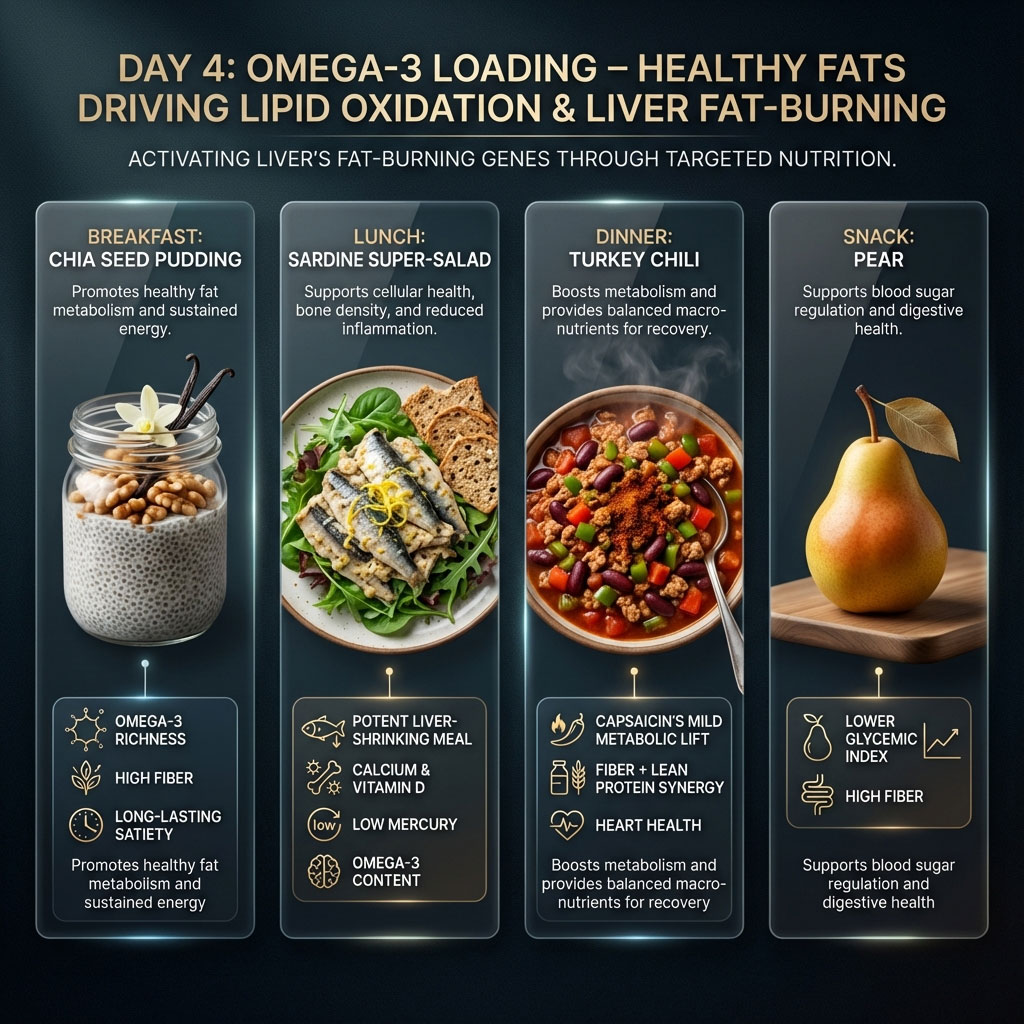
Breakfast: Chia Seed Pudding
- Method: Mix 3 tbsp chia seeds with 1 cup unsweetened almond milk and a drop of vanilla extract. Let sit in the fridge overnight. Top with walnuts before eating.
- Why It Works: Chia seeds expand in the stomach, keeping you full for hours. They are loaded with fiber and Omega-3s.
Lunch: The Sardine Super-Salad
- Ingredients: 1 tin sardines (in olive oil or water), mustard, lemon juice, mixed greens, whole-grain crackers.
- Method: Drain sardines and mash them in a bowl with 1 tsp mustard and a squeeze of lemon. Serve over a massive bed of greens or use crackers as scoops.
- Why It Works: This is the ultimate liver shrinking diet meal. Sardines are low on the food chain, meaning low mercury, but incredibly high in Omega-3s, calcium, and Vitamin D.
Dinner: Turkey Chili
- Ingredients: ½ lb lean ground turkey, 1 can kidney beans (rinsed), 1 can diced tomatoes, 1 bell pepper (chopped), 1 tbsp chili powder, ½ tbsp cumin.
- Method: Brown turkey in a large pot over medium heat (approx. 5-7 minutes). Add peppers and onions, cooking for another 3 minutes. Add tomatoes, beans, and spices. Bring to a boil, then reduce heat to low, cover, and simmer for 25–30 minutes to let flavors meld.
- Why It Works: High fiber from beans combined with lean protein keeps you full without spiking insulin. Capsaicin in chili powder may also slightly boost metabolism.
Snack
- Item: 1 pear. Pears are high in fiber and have a lower glycemic index than tropical fruits.
Day 5: Antioxidant Loading
Flooding the body with protective plant compounds to neutralize oxidative stress in liver cells.

Breakfast: Green Tea Smoothie
- Ingredients: Handful of spinach, 1 frozen banana, 1 cup chilled brewed green tea, 1 scoop vanilla protein powder (optional).
- Method: Blend on high until smooth.
- Why It Works: Delivers a concentrated dose of EGCG antioxidants directly to the system. The spinach provides folate, which supports methylation pathways in the liver.
Lunch: Leftover Turkey Chili
- Why It Works: Flavors in chili often improve the next day. Reheating leftovers prevents decision fatigue and impulse takeout orders.
Dinner: Mediterranean Pasta
- Ingredients: 2oz dry whole wheat pasta, 1 tbsp olive oil, 1 clove garlic (minced), ½ cup white beans (cannellini), 2 cups fresh spinach.
- Method: Boil pasta in salted water for 8–10 minutes (al dente). While pasta cooks, sauté garlic in olive oil over medium heat for 1 minute. Add spinach and beans, cooking until spinach wilts (2 minutes). Toss cooked pasta with the veggie mixture.
- Why It Works: Shows you can still eat pasta on a fatty liver diet plan if portioned correctly and balanced with fiber and healthy fats. The white beans effectively lower the glycemic impact of the pasta.
Snack
- Item: Hard-boiled egg. Simple, portable protein.
Day 6: The “Green Med” Day
Strict adherence to the Green Mediterranean protocol to maximize polyphenol intake.

Breakfast: Avocado Toast
- Ingredients: 1 slice whole grain bread (toasted), ½ ripe avocado (mashed), pinch of red pepper flakes.
- Why It Works: Avocado is unique because it contains a compound that may help protect the liver from galactosamine-induced injuries.
Lunch: Chickpea Salad
- Ingredients: ½ cup chickpeas, ¼ cup diced red pepper, ¼ cup diced red onion, 1 tsp olive oil, 1 tsp vinegar, salt, pepper.
- Why It Works: Chickpeas are resistant starch powerhouses. They feed the good bacteria in your gut. These bacteria produce short-chain fatty acids that help reduce liver fat.
Dinner: Roasted Mackerel or Salmon
- Ingredients: 1 fillet of Mackerel or Salmon (canned is also fine), 1 cup Brussels sprouts (halved).
- Method: Preheat oven to 400°F (200°C). Place fish and Brussels sprouts on a baking sheet. Drizzle everything with olive oil and season. Roast for 15–20 minutes. If using canned fish, just roast the veggies and serve fish cold or warmed on the side.
- Why It Works: Cruciferous veggies like Brussels sprouts increase liver detoxification enzymes naturally. Mackerel is an even potent source of Omega-3s than salmon and is often cheaper.
Snack
- Item: 1 square of 70% (or darker) dark chocolate. The polyphenols in dark chocolate improve blood vessel function in the liver.
Day 7: Simplicity & Prep
Using up leftovers to ensure zero food waste and saving money. This day prepares you for the week ahead.
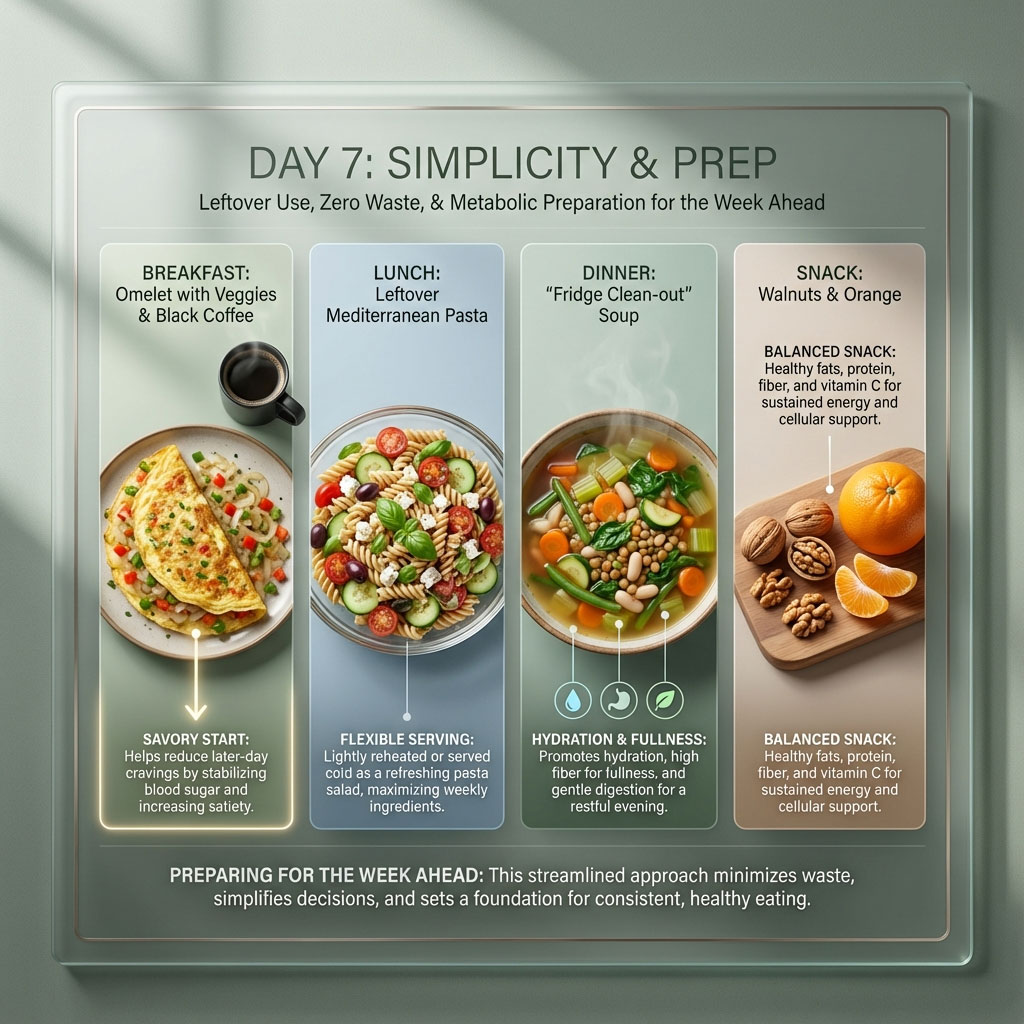
Breakfast: Omelet with Veggies
- Ingredients: Eggs, onions, and peppers. Black coffee.
- Why It Works: Starting the day with savory rather than sweet reduces cravings later in the day.
Lunch: Leftover Mediterranean Pasta
- Instructions: Reheat lightly on the stove or enjoy cold as a pasta salad.
Dinner: “Fridge Clean-out” Soup
- Ingredients: 4 cups low-sodium vegetable broth, all remaining veggies from the week, remaining beans or lentils.
- Method: Bring broth to a boil. Chop all leftover veggies into bite-sized pieces. Add to broth along with beans. Reduce heat and simmer for 20–25 minutes until all vegetables are tender.
- Why It Works: Soup is hydrating, filling, and ensures no expensive produce goes to waste. It is a gentle way to end the week, giving the digestive system a rest.
Snack
- Item: Walnuts and an orange.
The Science of Nutrient Timing for Liver Health
While what you eat matters immensely, how and when you eat can also influence the effectiveness of your 7-day fatty liver diet plan. Understanding nutrient timing can help you maximize the benefits of the foods listed above.

The Breakfast Principle: Breaking the Fast with Protein
For those with MASLD, the first meal of the day sets the metabolic tone. Eating a high-sugar breakfast, such as a bagel or sweetened cereal, spikes insulin immediately. Because liver fat accumulation is driven by insulin, this spike stops fat burning for the rest of the morning. It forces the body onto a “glucose rollercoaster” of spikes and crashes.
Instead, prioritizing protein and fiber at breakfast, like the Golden Oats or Veggie Scramble in our plan, provides a slow, steady release of energy. This prevents the insulin spike and keeps the liver in a “fat oxidation” mode, or burning fat, rather than a “lipogenesis” mode, or storing fat.
The Dinner Cut-Off
Late-night eating is particularly harmful to the liver. Your liver has its own circadian rhythm. It is designed to process nutrients during the day and detoxify or repair at night. When you eat a heavy meal or snack late at night, you force the liver to process energy when it should be resting. This metabolic mismatch can increase liver fat storage. Aim to finish your last meal at least three hours before bed. This fasting window allows the liver to deplete its glycogen stores and start mobilizing stored fat for energy while you sleep.
Foods to Eat vs. Foods to Avoid (The Traffic Light System)
To make long-term adherence easier, visualize your food choices as a traffic light. You do not need to memorize complex lists. You just need to know which category a food falls into.
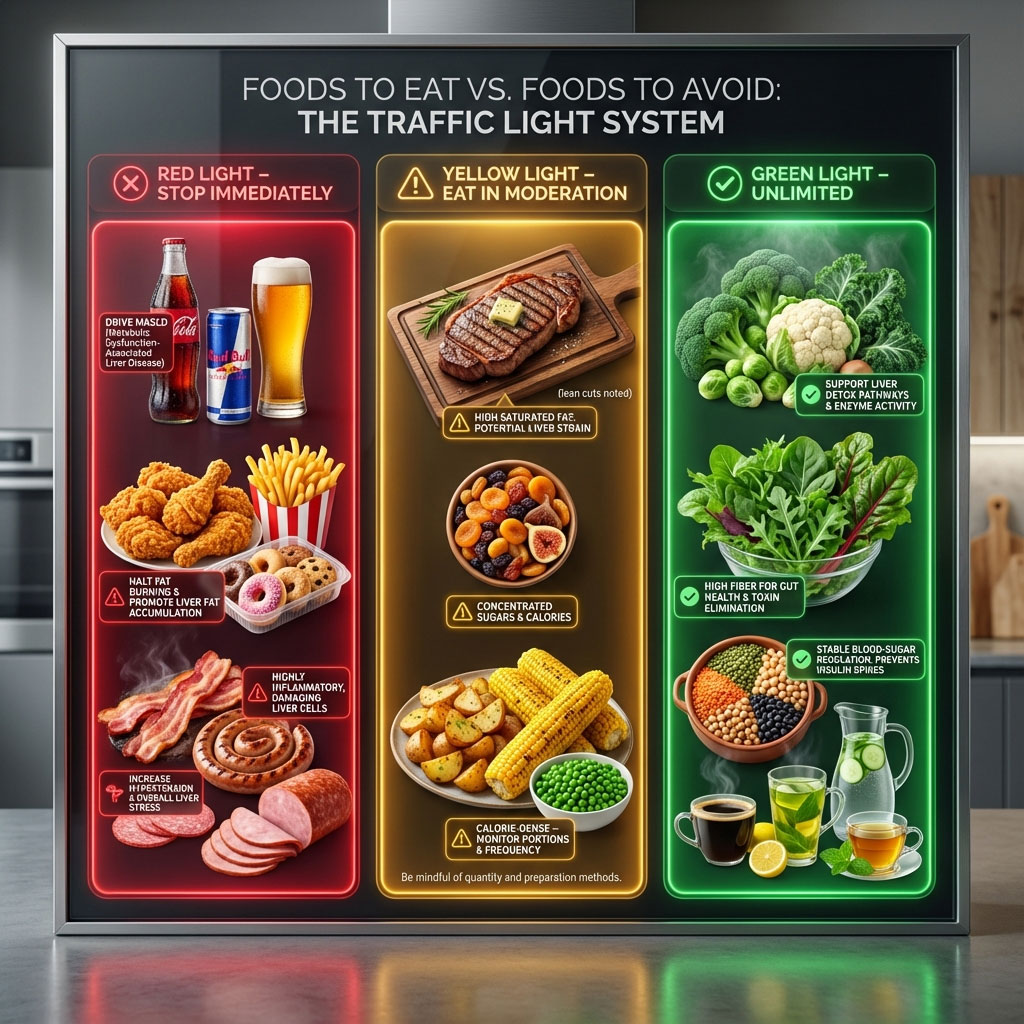
The Red Light List (Stop Immediately)
These foods actively damage liver cells and promote fat storage.
Sugar-Sweetened Beverages
Soda, sweet tea, sports drinks, and energy drinks are the primary drivers of MASLD. The high fructose content bypasses satiety signals and goes straight to the liver.
Alcohol
If you have fatty liver, alcohol acts as fuel on the fire. It stops fat burning immediately. Even moderate drinking can accelerate fibrosis in an already compromised liver.
Trans Fats
Found in fried fast foods, non-dairy coffee creamers, and shelf-stable baked goods. These fats are highly inflammatory and difficult for the liver to process.
Processed Meats
Bacon, sausages, and deli meats are often high in sodium and nitrates. High sodium intake can lead to fluid retention and hypertension, which often accompanies metabolic syndrome.
The Yellow Light List (Eat in Moderation)
These foods are not “bad,” but they should be limited to small portions.
Red Meat
Beef and pork can be high in saturated fat. While they provide iron and protein, excessive saturated fat can tax the liver. Choose lean cuts like sirloin or tenderloin and limit consumption to once or twice a week.
Dried Fruit
While natural, the sugar concentration is very high. Raisins, dates, and dried cranberries can spike insulin if eaten in large amounts. Use them sparingly as a garnish, not a snack.
Starchy Vegetables
Potatoes, corn, and peas are healthy whole foods but are calorie-dense. If you are trying to lose weight to reverse fatty liver, monitor your portion sizes of these starches.
The Green Light List (Unlimited)
You can eat these foods in abundance without worrying about liver fat.
Cruciferous Vegetables
Broccoli, cauliflower, kale, and Brussels sprouts contain compounds like sulforaphane that support the liver’s detoxification pathways.
Leafy Greens
Spinach, arugula, romaine, and chard are low in calories but high in magnesium and potassium.
Beverages
Black coffee, green tea, water, and herbal teas.
Legumes
Lentils, beans, chickpeas, and peas are high in resistant starch and soluble fiber, which help regulate blood sugar and bind to toxins in the gut.
| Meal Component | Standard American Diet (SAD) | Liver-Friendly Swap | Metabolic Benefit |
| Breakfast Cereal | Sugary flakes or loops | Oatmeal with Walnuts | High soluble fiber stabilizes blood sugar; walnuts provide Omega-3s. |
| Sandwich Bread | White Wonder Bread | Sprouted or Whole Wheat | Complex carbs digest slowly, preventing an insulin spike. |
| Snack | Potato Chips | Handful of Almonds | Replaces inflammatory seed oils with healthy monounsaturated fats. |
| Drink | 20oz Cola | Iced Green Tea | Eliminates ~65g of fructose; adds potent liver-protecting antioxidants. |
| Dinner Protein | Fried Chicken | Baked Salmon/Sardines | Reduces saturated fat load; increases anti-inflammatory fatty acids. |
Making It Taste Good: Flavor Without Sugar
A fatty liver diet plan fails when it becomes boring. Flavor is not the enemy. Sugar and unhealthy fats are the enemy. You can make your meals incredibly satisfying by using herbs and spices that actually double as medicine.
Spices as Medicine

Turmeric (Curcumin)
As mentioned in the 7-day diet plan for fatty liver, turmeric is a powerhouse. It reduces inflammation markers in the liver. However, curcumin is poorly absorbed on its own. Always pair it with black pepper, which contains piperine, and a source of fat like olive oil or nuts to increase absorption by up to 2,000%.
Garlic
Studies suggest garlic powder can reduce body weight and fat content in people with MASLD. Use it generously in marinades, soups, and roasted vegetables.
Ginger
Improves insulin sensitivity and aids digestion. Fresh ginger tea is an excellent addition to your morning routine.
Cinnamon
Ceylon cinnamon helps lower blood sugar levels. Sprinkle it on your coffee grounds before brewing or on your oatmeal. Avoid “Cassia” cinnamon in large amounts if possible, as it contains coumarin which can be hard on the liver in extremely high doses.
Cooking Methods Matter
How you cook is just as important as what you cook. Deep frying is obviously out, but you do not have to stick to steaming.
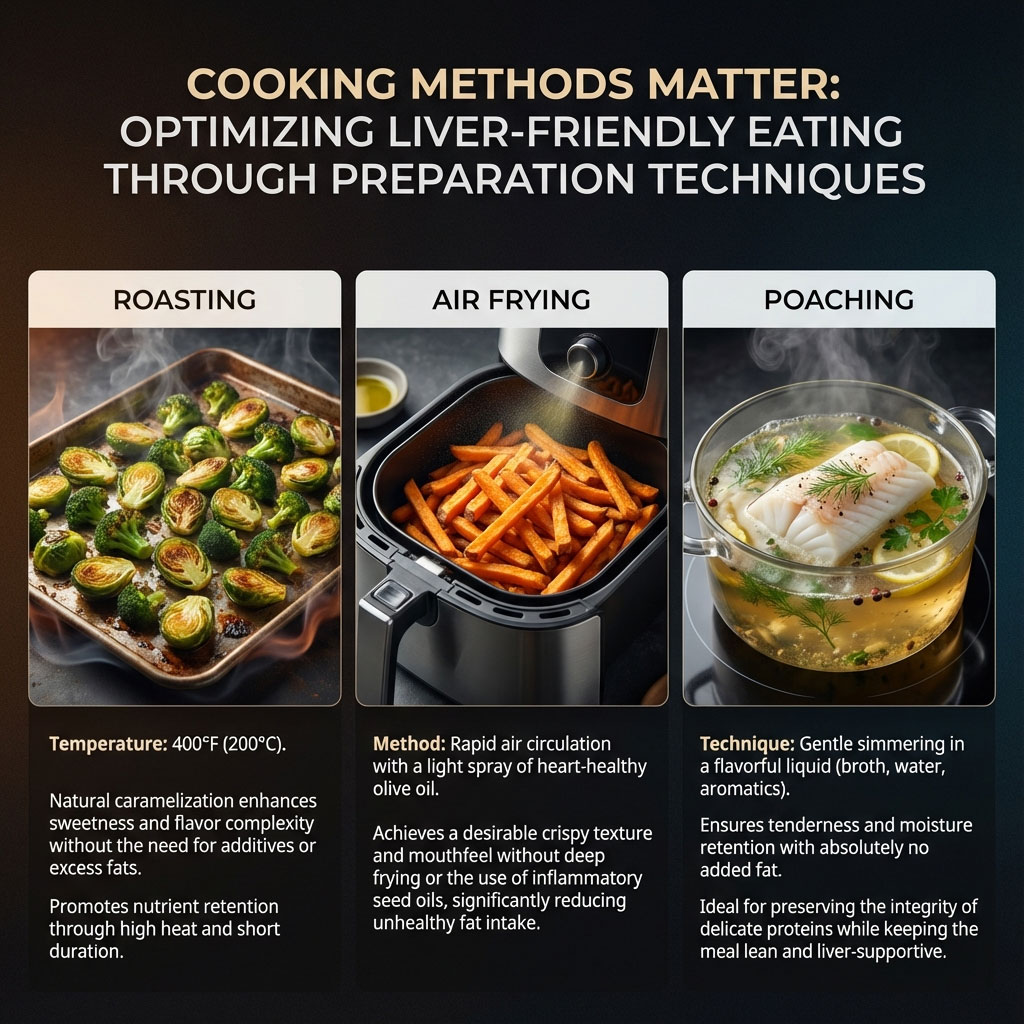
Roasting
Roasting vegetables at high heat (400°F) caramelizes their natural sugars, making them taste sweet and savory without additives. This is the secret to making Brussels sprouts and broccoli delicious.
Air Frying
An excellent tool for fatty liver patients. You can get crispy “fries” from sweet potatoes or crispy chicken wings using just a spray of olive oil. This mimics the texture of fried food without the inflammatory seed oils.
Poaching
Poaching fish or chicken in broth or water keeps the meat tender without adding extra fat. It is perfect for delicate fish that might dry out in the oven.
Lifestyle Synergies: Speeding Up Results
Diet is responsible for about 80% of the results, but you can accelerate your progress with two specific lifestyle levers. These habits act as multipliers for your dietary efforts.
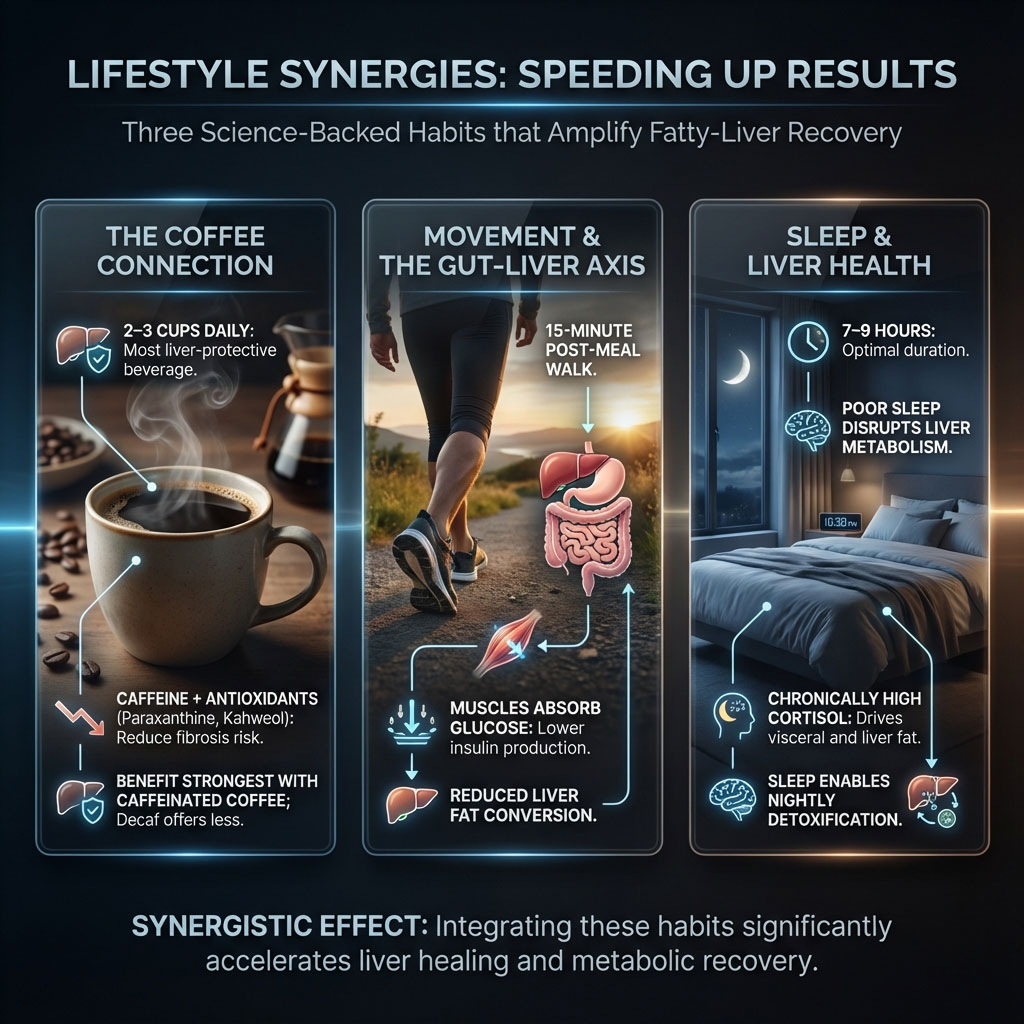
The Coffee Connection
If you are a coffee drinker, do not stop. Coffee is arguably the most liver-protective beverage on the planet. Studies consistently show that drinking 2-3 cups of black coffee daily is associated with a lower risk of liver fibrosis and hepatocellular carcinoma. The caffeine and antioxidants, specifically paraxanthine and kahweol, in coffee help prevent the accumulation of collagen in the liver, which causes scarring. Note that this benefit applies to regular caffeinated coffee. Decaf offers some benefit but less than fully caffeinated coffee.
Movement & The Gut-Liver Axis
You do not need to run a marathon. The most effective exercise for insulin resistance is walking, specifically walking after a meal.
Taking a 15-minute walk immediately after lunch or dinner activates your muscles to soak up glucose from your bloodstream. This means your pancreas produces less insulin, and your liver is under less pressure to convert that glucose into fat. It is a simple habit that supercharges your fatty liver diet plan.
Sleep and Liver Health
The liver operates on a biological clock. Poor sleep or irregular sleep patterns can disrupt the liver’s metabolism, leading to increased fat storage. Aim for 7-9 hours of quality sleep. Chronic sleep deprivation increases cortisol, a stress hormone that drives visceral fat accumulation directly in the abdomen and liver. Prioritizing sleep is as important as prioritizing vegetables. When you sleep, your liver works to clear toxins accumulated during the day. Give it the time it needs to do the job.
Reading Nutrition Labels: A Skill for Liver Health
Navigating the grocery store requires vigilance. Food marketing can be deceptive, labeling products as “healthy” or “natural” when they are laden with liver-damaging ingredients. Here is how to read a label for MASLD:
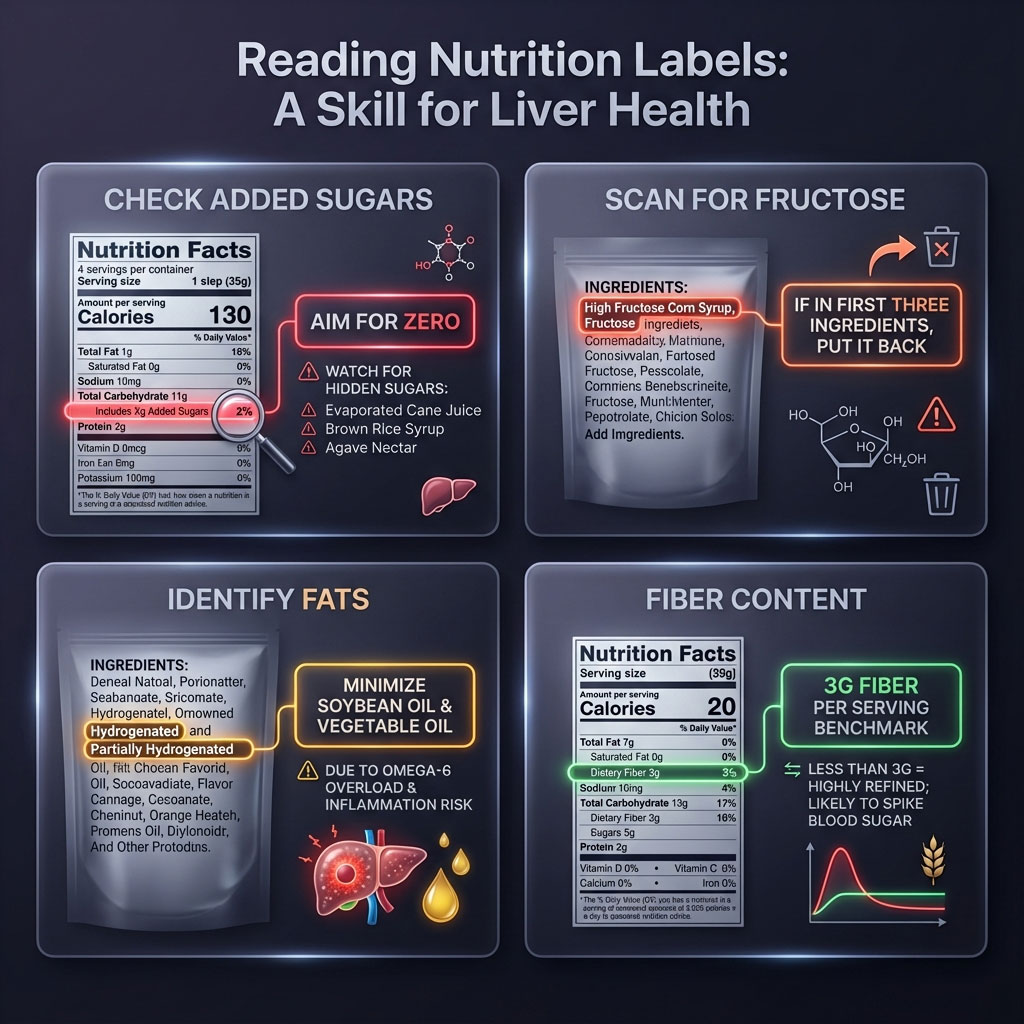
1. Check Added Sugars
Look specifically for the “Added Sugars” line under Carbohydrates. Aim for as close to zero as possible. Be wary of hidden names for sugar like evaporated cane juice, brown rice syrup, and agave nectar.
2. Scan for Fructose
If “High Fructose Corn Syrup” or “Fructose” appears in the first three ingredients, put the product back.
3. Identify Fats
Avoid “Hydrogenated” or “Partially Hydrogenated” oils. These are trans fats. Also, try to minimize soybean oil and vegetable oil in processed foods, as they are high in Omega-6 fatty acids which can be pro-inflammatory when consumed in excess relative to Omega-3s.
4. Fiber Content
Look for at least 3 grams of fiber per serving in grain products. If a bread or cracker has less than that, it is likely highly refined and will spike your blood sugar.
Summary & Key Takeaways
Reversing MASLD is entirely possible, and you now have a blueprint to achieve it. This 7-day diet plan for fatty liver is not just about getting through the week. It is about resetting your palate and your metabolism. It is about moving from a state of storage and inflammation to a state of burning and repair.
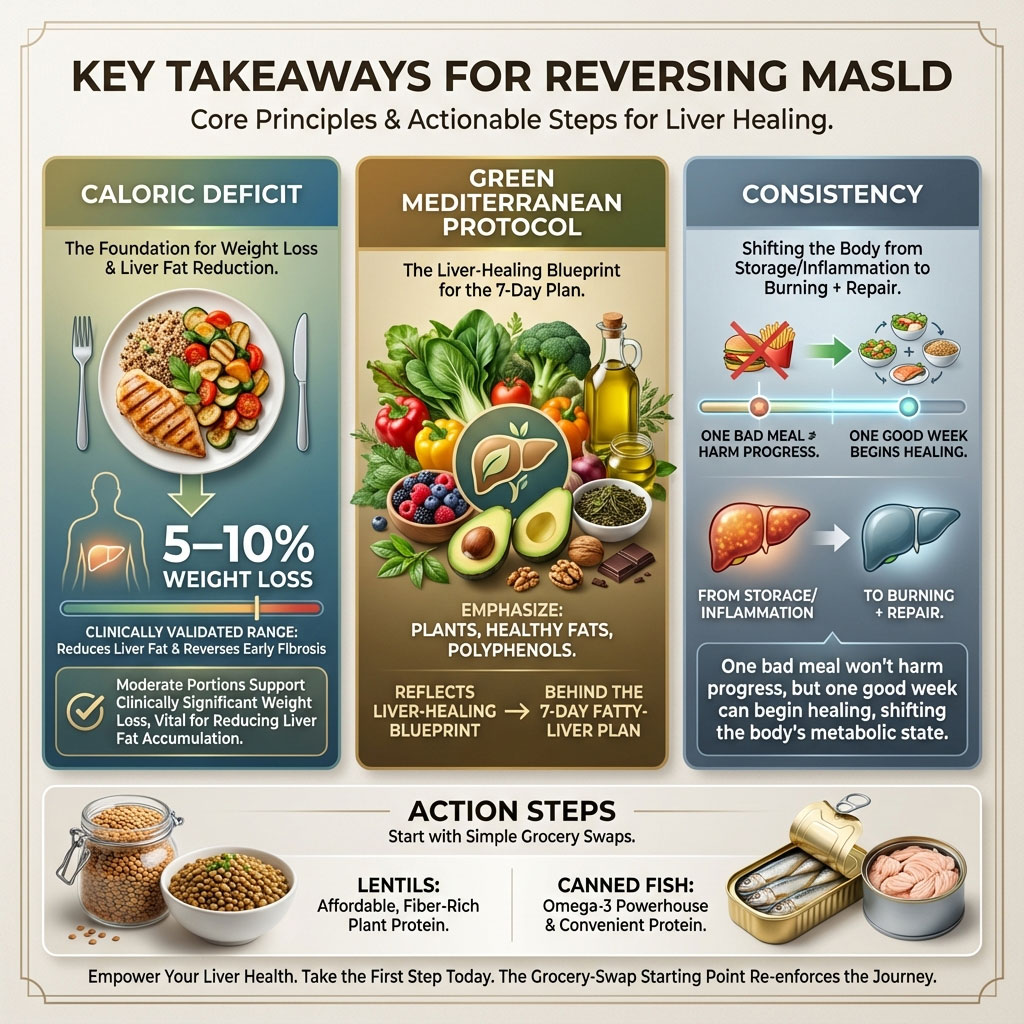
Remember the three pillars of success:
- Caloric Deficit: Moderate portion sizes to achieve 5-10% weight loss.
- Green Mediterranean Protocol: Prioritize plants, healthy fats, and polyphenols.
- Consistency: One bad meal will not ruin your liver, but one good week can start the healing process.
Start with the grocery swaps. Buy the lentils and the canned fish. Make the commitment to your health today. Your liver is resilient, and with the right fuel, it can repair itself.
Frequently Asked Questions (FAQs)
Can a 7-day diet plan really cure fatty liver?
No diet can “cure” fatty liver in just 7 days, as liver fat accumulation takes years to develop. However, a strict 7-day plan can significantly deplete liver glycogen, reduce water retention, and kickstart the fat-burning process. It sets the foundation for the 5-10% weight loss required for full reversal over several months. Think of this week as a metabolic intervention that stops the damage and pivots your body toward healing.
What is the absolute worst food for fatty liver?
Sugar-sweetened beverages containing high-fructose corn syrup are the single worst item for fatty liver. Unlike glucose, fructose is processed almost exclusively by the liver, where it rapidly converts to fat. Eliminating soda, sweet tea, and juice is the most impactful step you can take. Even “100% fruit juice” should be avoided because the fiber has been removed, turning it into a pure sugar hit for the liver.
Is coffee good for MASLD/fatty liver?
Yes, coffee is highly beneficial. Research shows that drinking 2 to 3 cups of unsweetened black coffee daily can lower liver enzymes and reduce the risk of fibrosis (scarring). It is one of the few beverages actively recommended by hepatologists. Light roast coffee tends to have slightly higher levels of antioxidants than dark roast, but both are beneficial.
How much weight do I need to lose to reverse fatty liver?
Clinical guidelines state that losing 3-5% of your body weight can reduce liver fat levels. Losing 7-10% of your body weight can reduce inflammation and potentially reverse liver damage (fibrosis). Slow, steady weight loss is safer than rapid crash dieting. Losing weight too quickly (more than 3 lbs per week) can actually worsen fatty liver by mobilizing too much fat at once, so aim for a sustainable pace.
Are eggs safe for a fatty liver diet?
Yes, eggs are safe and beneficial in moderation. They are a primary source of choline, a nutrient essential for liver function and fat metabolism. Choline helps export fat out of the liver. If you have high cholesterol, you may want to limit egg yolks to 3-4 per week or utilize egg whites, but they fit well into a fatty liver meal plan.
Can I eat bananas on a fatty liver diet?
Yes, you can eat bananas, but moderation is key due to their sugar content. It is best to eat them when they are slightly green (lower sugar, higher resistant starch) or pair them with a fat source like nuts or peanut butter to blunt the insulin spike. Avoid overly ripe, brown-spotted bananas, as their sugar content is much higher and absorbs more rapidly.
Is oatmeal good for liver repair?
Oatmeal is excellent for the liver, provided it is steel-cut or rolled oats rather than instant packets with added sugar. Oats are high in beta-glucan, a type of soluble fiber that helps reduce cholesterol and improve liver function. Beta-glucan also creates a gel-like substance in the gut that slows down the absorption of sugars, further protecting the liver from insulin spikes.
What is the difference between NAFLD and MASLD?
NAFLD (Non-Alcoholic Fatty Liver Disease) is the older term that defined the disease by the absence of alcohol use. MASLD (Metabolic dysfunction-Associated Steatotic Liver Disease) is the modern term that accurately describes the condition as a metabolic disorder linked to insulin resistance, obesity, and diabetes. The new criteria require the presence of at least one metabolic risk factor (like high blood pressure or prediabetes) alongside liver fat.
How can I follow this diet on a tight budget?
Focus on non-perishable and frozen whole foods. Canned sardines, mackerel, beans, and lentils are incredibly cheap protein sources. Frozen broccoli, spinach, and berries offer the same nutrition as fresh options for half the price. Buying oats and brown rice in bulk also reduces costs significantly. Preparing meals at home is almost always cheaper than eating out, even when buying healthier ingredients.
Do I need supplements like Milk Thistle?
While Milk Thistle is a popular supplement, clinical data on its effectiveness is mixed. The American Liver Foundation emphasizes that nutrition and weight loss are the primary treatments. Supplements should never replace a healthy diet and should only be taken under a doctor’s supervision. Some supplements can actually harm the liver if not monitored, so food is always the safest medicine.
Is the Keto diet safe for fatty liver?
It depends on the type of Keto. A “Dirty Keto” diet high in bacon, butter, and processed meats can worsen liver inflammation due to the high saturated fat content. However, a “Mediterranean Keto” or low-carb approach rich in olive oil, fish, nuts, and greens is highly effective for reducing liver fat quickly. The key is the quality of the fats you consume.
What should I eat for breakfast to help my liver?
The best breakfast for fatty liver combines fiber and protein to stabilize blood sugar. Good examples include oatmeal with walnuts and berries, a vegetable omelet with whole-grain toast, or Greek yogurt with flaxseeds. Avoid sugary cereals, pastries, and white bagels, as these cause a rapid rise in blood glucose that forces the liver to store fat immediately.
Disclaimer: This content is for informational purposes only and does not constitute medical advice. The information regarding diet and health conditions is based on current research but should not replace professional medical diagnosis or treatment. Consult your hepatologist or a registered dietitian before starting any new diet or weight loss plan.

